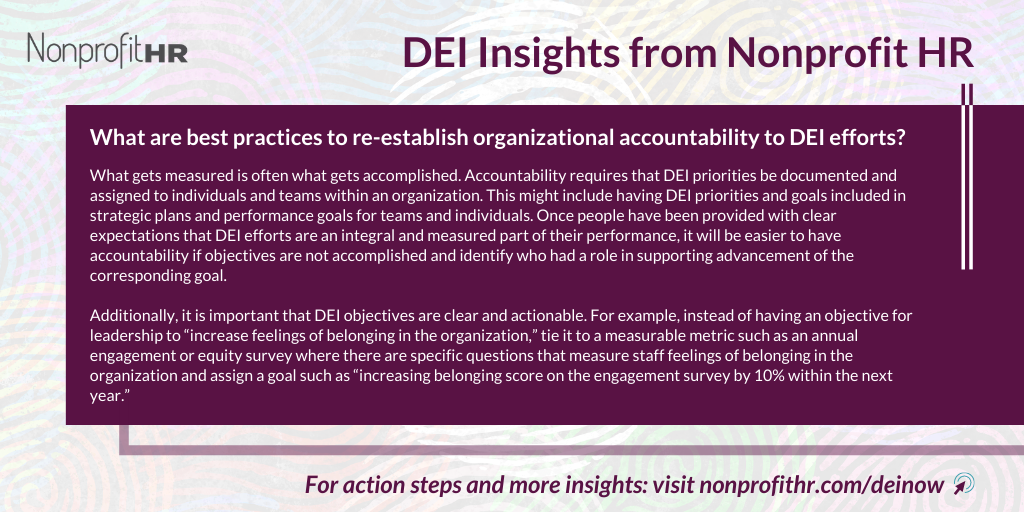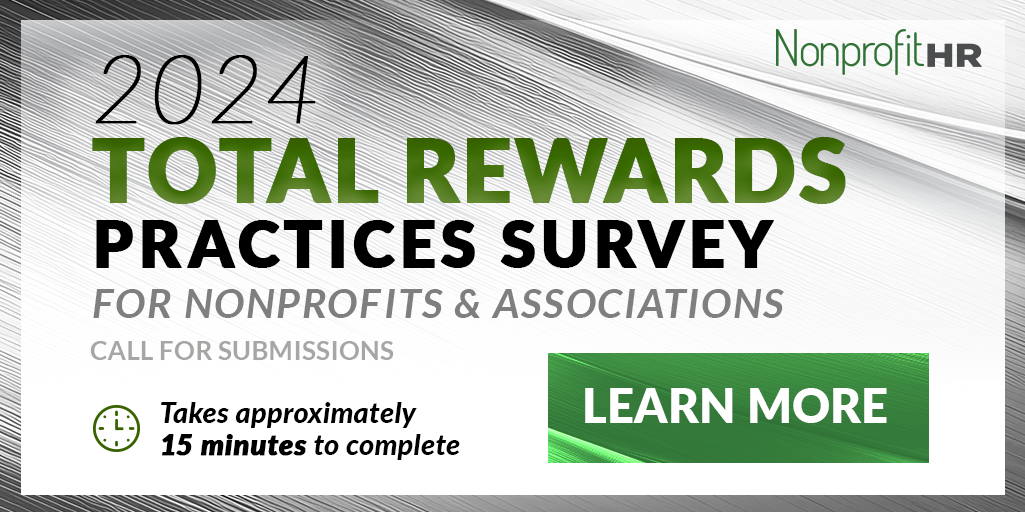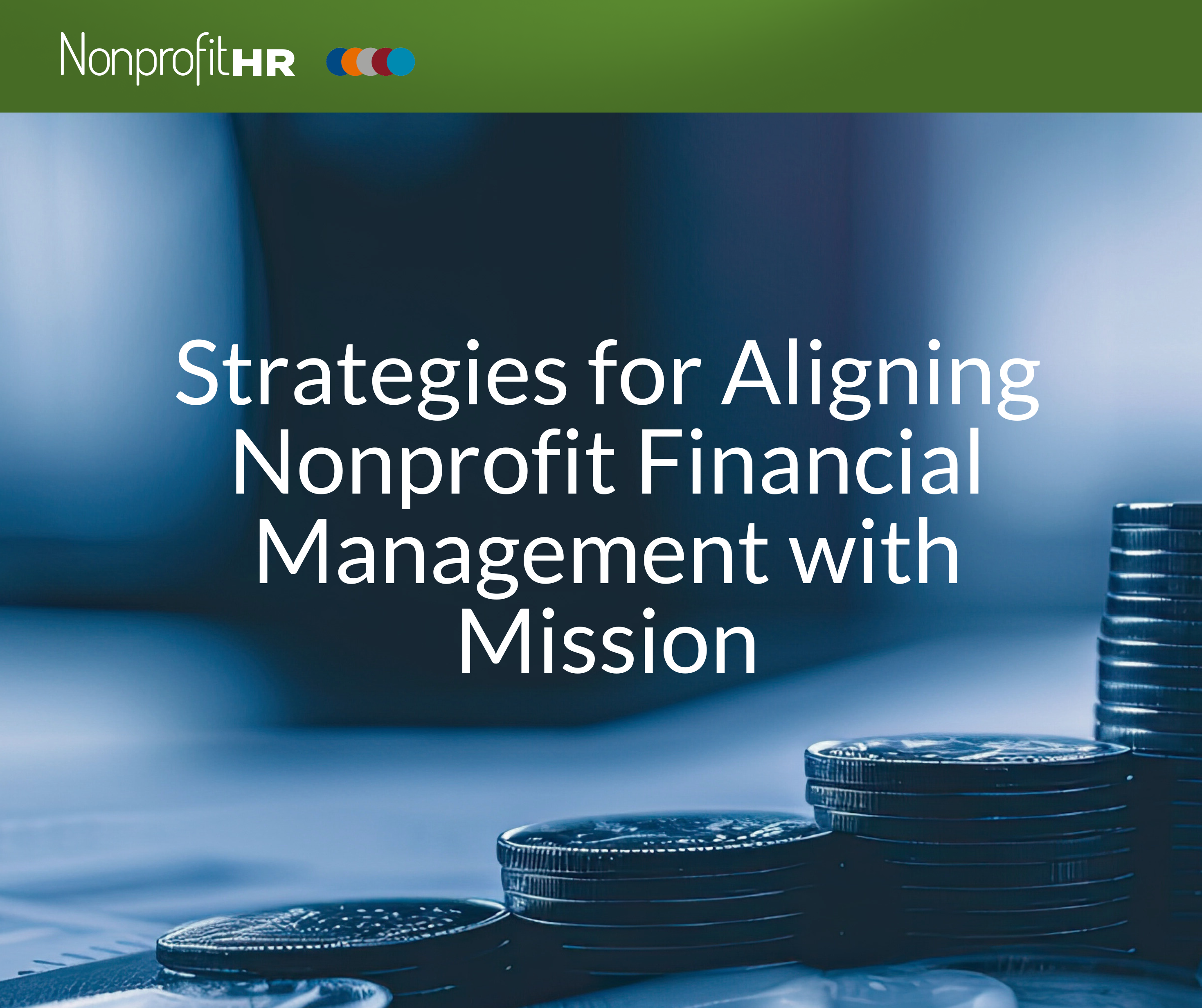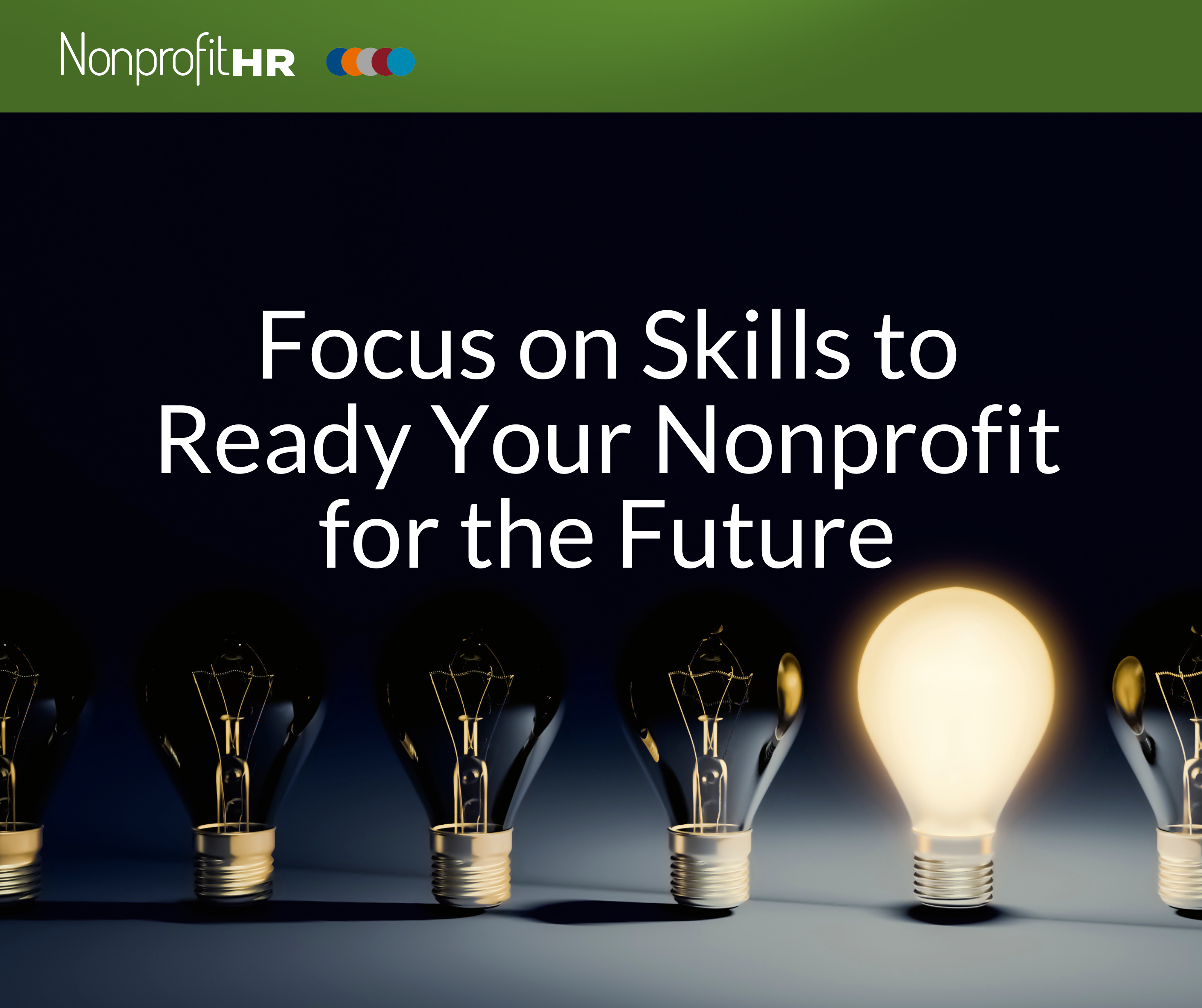WTOP: 5 ways nonprofits can…
Nonprofit HR has received many questions from social impact organizations and has decided to share the responses with the public. Visit this page to see new questions and answers your peers are asking about diversity, equity and inclusion (DEI) in their organizations.
Question: What does the process of developing a DEI strategy and statement look like?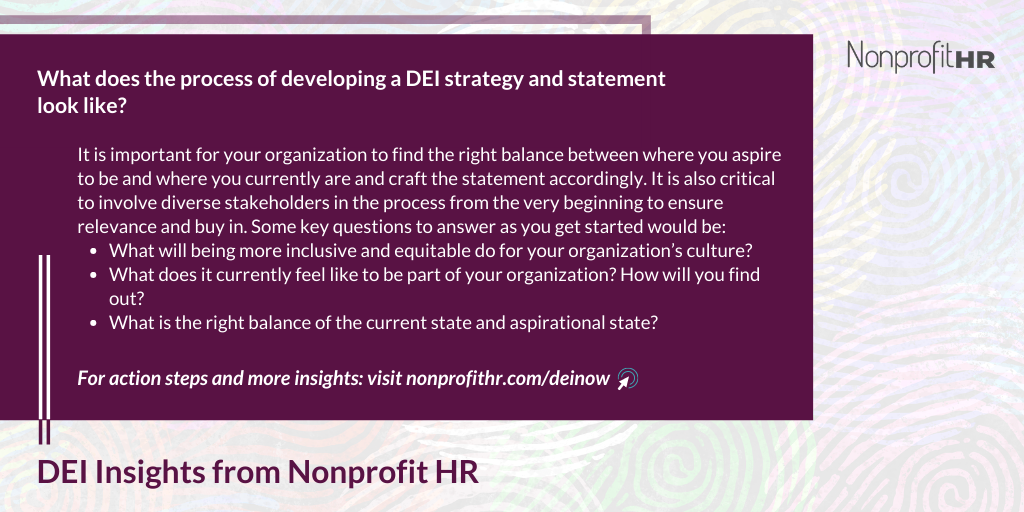
Nonprofit HR’s Response: It is important for your organization to find the right balance between where you aspire to be and where you currently are and craft the statement accordingly. It is also critical to involve diverse stakeholders in the process from the very beginning to ensure relevance and buy in. Some key questions to answer as you get started would be:
- What will being more inclusive and equitable do for your organization’s culture?
- What does it currently feel like to be part of your organization? How will you find out?
- What is the right balance of the current state and aspirational state?
Question: What are best practices to re-establish organizational accountability to DEI efforts?
Nonprofit HR’s Response: What gets measured is often what gets accomplished. Accountability requires that DEI priorities be documented and assigned to individuals and teams within an organization. This might include having DEI priorities and goals included in strategic plans and performance goals for teams and individuals. Once people have been provided with clear expectations that DEI efforts are an integral and measured part of their performance, it will be easier to have accountability if objectives are not accomplished and identify who had a role in supporting advancement of the corresponding goal.
Additionally, it is important that DEI objectives are clear and actionable. For example, instead of having an objective for leadership to “increase feelings of belonging in the organization,” tie it to a measurable metric such as an annual engagement or equity survey where there are specific questions that measure staff feelings of belonging in the organization and assign a goal such as “increasing belonging score on the engagement survey by 10% within the next year.”
Question: What are best practices to create safe spaces to have conversations in a virtual workplace?
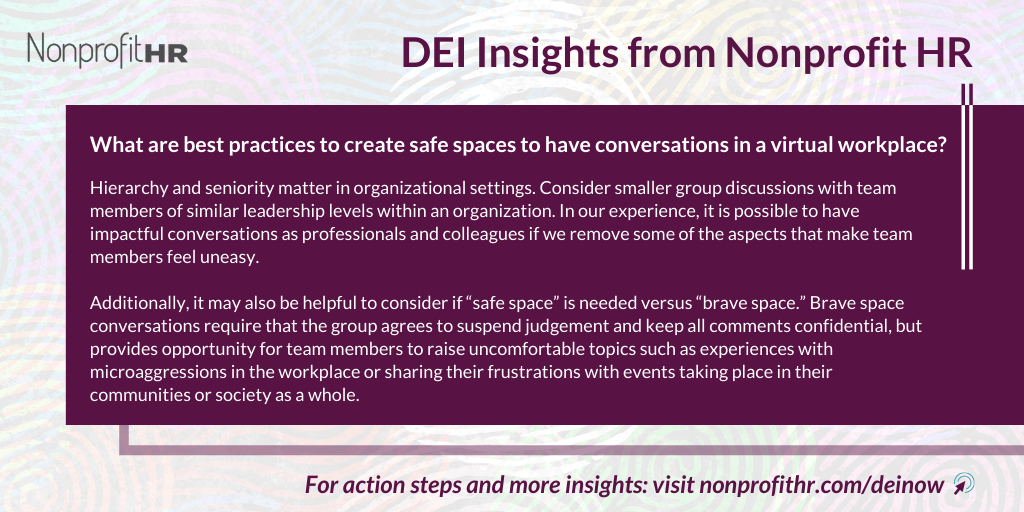 Nonprofit HR’s Response: Hierarchy and seniority matter in organizational settings. Consider smaller group discussions with team members of similar leadership levels within an organization. In our experience, it is possible to have impactful conversations as professionals and colleagues if we remove some of the aspects that make team members feel uneasy.
Nonprofit HR’s Response: Hierarchy and seniority matter in organizational settings. Consider smaller group discussions with team members of similar leadership levels within an organization. In our experience, it is possible to have impactful conversations as professionals and colleagues if we remove some of the aspects that make team members feel uneasy.
Additionally, it may also be helpful to consider if “safe space” is needed versus “brave space.” Brave space conversations require that the group agrees to suspend judgement and keep all comments confidential, but provides opportunity for team members to raise uncomfortable topics such as experiences with microaggressions in the workplace or sharing their frustrations with events taking place in their communities or society as a whole.
Question: How do you implement DEI without looking like you are discriminating?
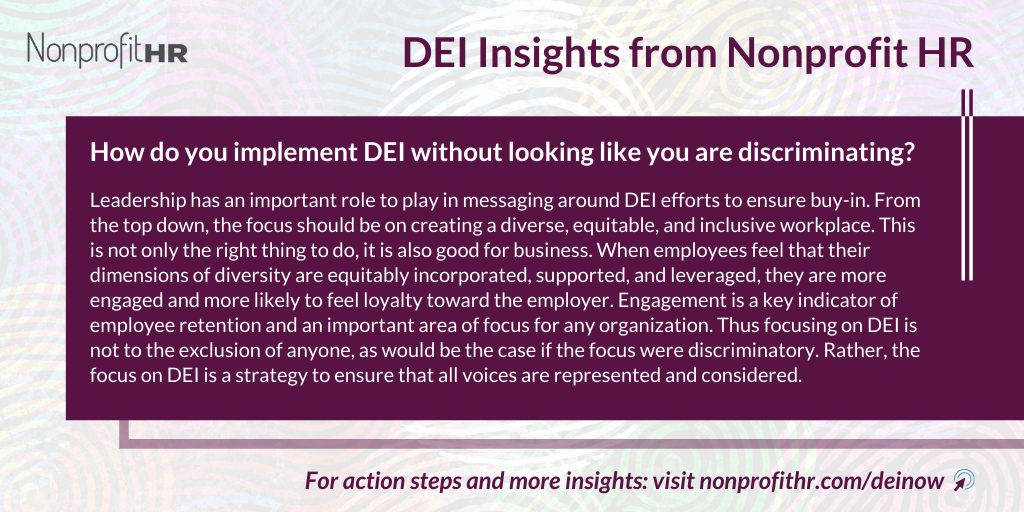 Nonprofit HR’s Response: Leadership has an important role to play in messaging around DEI efforts to ensure buy-in. From the top down, the focus should be on creating a diverse, equitable, and inclusive workplace. This is not only the right thing to do, it is also good for business. When employees feel that their dimensions of diversity are equitably incorporated, supported, and leveraged, they are more engaged and more likely to feel loyalty toward the employer. Engagement is a key indicator of employee retention and an important area of focus for any organization. Thus focusing on DEI is not to the exclusion of anyone, as would be the case if the focus were discriminatory. Rather, the focus on DEI is a strategy to ensure that all voices are represented and considered.
Nonprofit HR’s Response: Leadership has an important role to play in messaging around DEI efforts to ensure buy-in. From the top down, the focus should be on creating a diverse, equitable, and inclusive workplace. This is not only the right thing to do, it is also good for business. When employees feel that their dimensions of diversity are equitably incorporated, supported, and leveraged, they are more engaged and more likely to feel loyalty toward the employer. Engagement is a key indicator of employee retention and an important area of focus for any organization. Thus focusing on DEI is not to the exclusion of anyone, as would be the case if the focus were discriminatory. Rather, the focus on DEI is a strategy to ensure that all voices are represented and considered.
Need direct advice from Nonprofit HR? Schedule a mini-consult!
Note: While Nonprofit HR is sharing answers with the public through this mechanism, these answers should not be wholly applied to any business and decision-making scenario organizations are facing. Organizations should partner with their Human Resources and talent management staff/consultants and advisors to create solutions for their unique challenges. No information shared on this page should be taken as Nonprofit HR direct advice for any challenges organizations are facing.






























